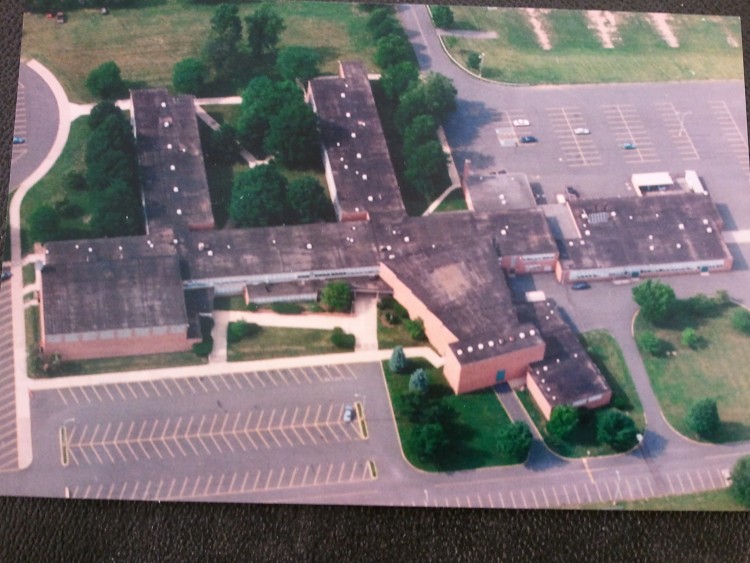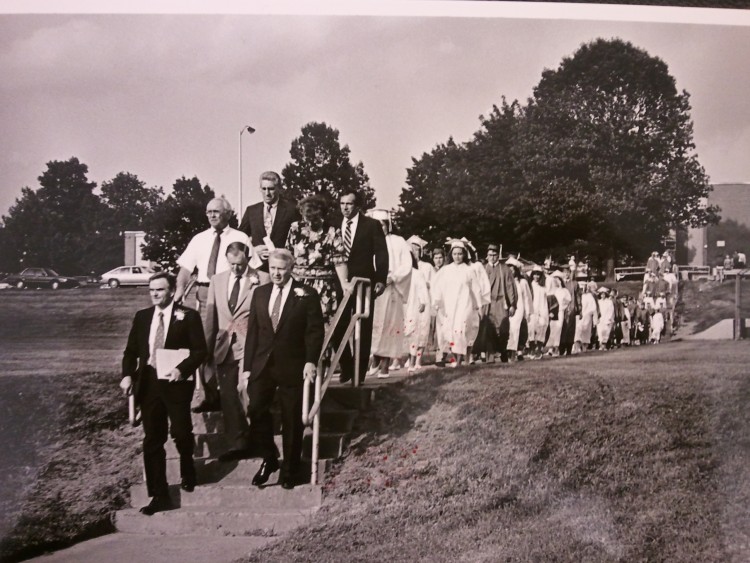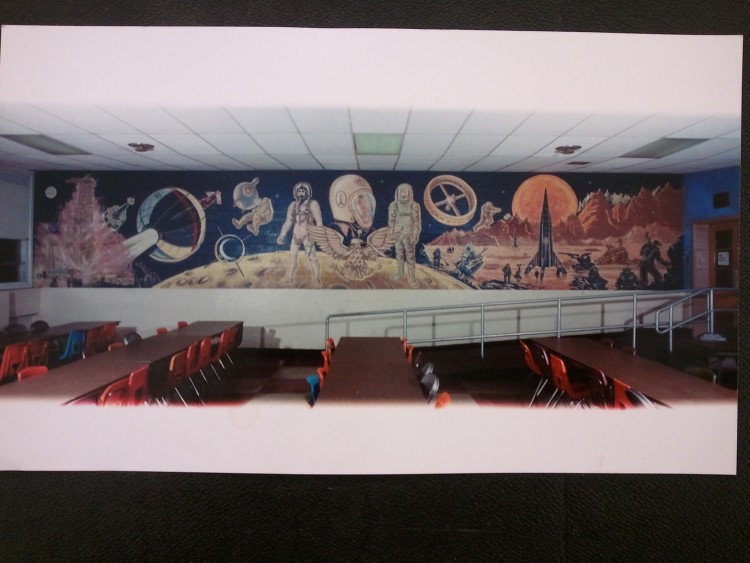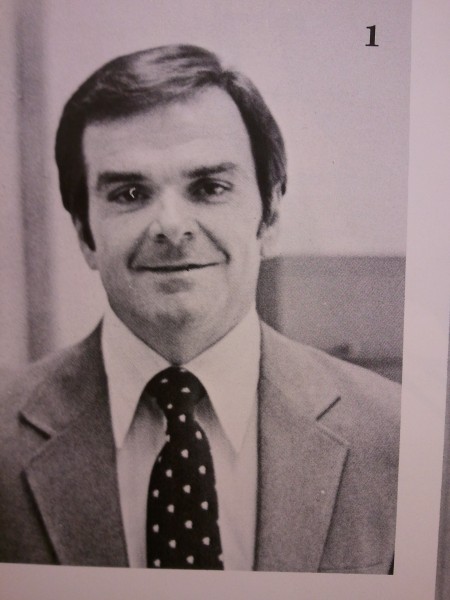It is best to begin from above and from before.
 You have the photograph of the High School as it appeared before the additions and renewal of the late 90’s. Originally opened in 1957 on a high field and woodland, by the late 70’s it had recovered some of its green feel. Look at the trees that surround its wings and crowd the space between them. The classrooms had huge windows that opened far enough for big young men to be able to clamber out. We could watch birds and chipmunks from our desks. But what seems paradisiacal was not. By the late 70’s the HS was under siege – the smoking area, (it stretched between the two wings to the north) an effort to clean up the bathrooms and appease the desire for more student independence, had become a squalid free-fire zone of fights and drugs. Classrooms were packed, wall to windows, chalkboard to back bookcases — 35, 37, 40 kids bunched together in rooms that alternately boiled or froze; lots of kids cut classes and wandered the hallways. Smoke curled out from the bathrooms, assemblies had become so uncontrolled that most were cancelled, cafeteria duty was a three-stooges battle zone, two or three serious fights a week were the norm and the various curriculums made desperate attempts to recapture students’ academic interest with a catalogue of quarter courses. Like a high tide, the entire student body shifted to new courses and teachers every nine weeks in English and Social Studies. Graduation ceremonies were raucous gatherings of tribes, as dignified as a frat party.
You have the photograph of the High School as it appeared before the additions and renewal of the late 90’s. Originally opened in 1957 on a high field and woodland, by the late 70’s it had recovered some of its green feel. Look at the trees that surround its wings and crowd the space between them. The classrooms had huge windows that opened far enough for big young men to be able to clamber out. We could watch birds and chipmunks from our desks. But what seems paradisiacal was not. By the late 70’s the HS was under siege – the smoking area, (it stretched between the two wings to the north) an effort to clean up the bathrooms and appease the desire for more student independence, had become a squalid free-fire zone of fights and drugs. Classrooms were packed, wall to windows, chalkboard to back bookcases — 35, 37, 40 kids bunched together in rooms that alternately boiled or froze; lots of kids cut classes and wandered the hallways. Smoke curled out from the bathrooms, assemblies had become so uncontrolled that most were cancelled, cafeteria duty was a three-stooges battle zone, two or three serious fights a week were the norm and the various curriculums made desperate attempts to recapture students’ academic interest with a catalogue of quarter courses. Like a high tide, the entire student body shifted to new courses and teachers every nine weeks in English and Social Studies. Graduation ceremonies were raucous gatherings of tribes, as dignified as a frat party.
The Space Mural at the east end of the caf prior to reconstruction (student artist, Robert Mason, advised by Lou Gaston, art teacher)
The principal, a decent enough man, had no natural command presence; he was overwhelmed by the chaos. He spent most of his time in his office. Two factors prevented the school from descending into a Lord-of-the-Flies scene – a veteran staff with a core of superb teachers and leaders and an uncommon decency among most of the District’s children that persisted during all the time I spent there and that continues today.
Bill in the fall of 1980
The principal was fired in June of 1979 after a disastrous graduation ceremony and a final reckless and irrational evaluation of his staff. Bill Faulkner arrived in November of 1979. He had the face of one of those young brawlers you see in old photos of the tenements of Glasgow and Edinburgh, all sharp angles and unblinking gaze. He came to us from the West Chester schools where he had been an assistant principal and earned his pay helping keep order in a tough high school.
He was a carpenter. While he was principal, he built his log cabin home. He had been offered the job on the condition that he move into the District. The Board wanted someone who would become a part of the community. A good athlete in his youth, a point guard and infielder, he ran the dirt road near his home with his dog after work.
He had been given one all important objective – restore order to the HS. He possessed what the military call command presence, the projected sense of competence, judgment and toughness “that encourages loyalty and discipline in others, making them more enthusiastic and effective.”*
Without order, students will feel unsafe, parents will worry, the community will become uneasy and impatient, and teachers will not teach effectively. Disorder breeds more disorder. Stability and safety and calm routines are the essential prerequisites for good schools.
Bill did not smile very much in the hallways during his first months. He walked the hallways, set himself in the lobby and at intersections during passing time; he spoke to teachers, asked how they were doing, and he watched and watched. He did not shout. There were no demonstrations of machismo. There were no empty threats. He watched and never broke off from looking into any student’s eyes or from any group’s gaze. Collectively, both students and teachers took his measure, and the HS began to settle. It took time to make the changes in procedures and rules, time to send messages, time to clean out the bathrooms, time to establish a new normal. He had the support of an exceptional Superintendent and a very good School Board.
He came back to his office after hours and worked in the quiet. He kept a baseball bat propped next to his book case – the HS’s doors were rickety wooden contraptions held shut at night by chains. There was no security, and there had been break-in’s. Each morning, before leaving his home, he wrote down a verse from the Bible on a slip of paper and carried it with him all day. He kept the pressures of the job to himself. At twilight he ran with his retriever on the gravel road under the trees.
He never shamed himself by trying to curry favor. For example, at one School Board meeting, several principals gave their building reports before him. There was lots of fawning and morsels of baloney and long, and then longer accounts. When it was his turn, Bill stepped to the microphone and in 30 seconds had delivered a handful of facts in a deadpan, flattened voice, and then said that there was nothing else to report. The HS teachers in the crowd looked at each other and smiled. He did not have even a fraction of a percent of BS in him.
The graduation procession to the football field sometime in the 90’s.
 Graduation in June of 1980, Bill’s first, was as methodically organized as a invasion. Nothing was left to chance. There would be no surprises. It would be polite, composed, civilized, respectable. Before the first practice, the assembled seniors were told this in clear, short sentences that left no room for argument. Thirty seconds after he finished, he threw a kid out of that practice for being disruptive. Message sent. Message received. Graduation day was hot, the speakers went on for too long, the senior class was enormous so it took forever to read their names, but each part clicked off quietly and efficiently and with dignity. This was the public proof that the HS had begun to turn around.
Graduation in June of 1980, Bill’s first, was as methodically organized as a invasion. Nothing was left to chance. There would be no surprises. It would be polite, composed, civilized, respectable. Before the first practice, the assembled seniors were told this in clear, short sentences that left no room for argument. Thirty seconds after he finished, he threw a kid out of that practice for being disruptive. Message sent. Message received. Graduation day was hot, the speakers went on for too long, the senior class was enormous so it took forever to read their names, but each part clicked off quietly and efficiently and with dignity. This was the public proof that the HS had begun to turn around.
Over the years he steadily amassed credibility, and as he did so, and as the major impetus of what can now be seen as a creative team effort with the Board and Central Office, he made the HS a better place. Class sizes went down dramatically, a dozen new AP courses were added, curriculums stabilized and became logical and systematic, the building became cleaner, discipline and order markedly improved, staff morale soared. When the HS population dropped from 1400 to less than 800 over a period of years, he fought to keep his people employed, and he kept the course offerings intact that had been put in place when there had been so many more students. He instituted a Student Crisis Team that to this day continues to help kids who grow desperate or who have suffered. He put in place the best program for academically challenged students the HS has ever had – Making A Connection, MAC for short, which paired teachers and curriculums in such a way that these students who had often been relegated to the shadows of HS attention received the intellectual and emotional support they needed to succeed. These were the kids who always came first in his heart.
 With Superintendent Terry Furin and his assistant, Joe Corabi (who succeeded Bill as principal) sometime in the 90’s.
With Superintendent Terry Furin and his assistant, Joe Corabi (who succeeded Bill as principal) sometime in the 90’s.
In person, in a one on one meeting, he listened carefully, and once he had listened and asked questions, he gave three possible answers: “Let me think about it, Yes, or No.” If he said No, that was it and you knew it. You had to improve your position or move on. In answering No, however, he often said, “Here’s the other side,” and he explained. “Let me think about it” was a good answer because you knew he would do so in a serious manner.
Two qualities showed him at his best. He worked as hard as anyone I have ever seen to be fair. He never played favorites. There was right and there was wrong. If you were wrong, no matter the friendliness of your relationship, you had to bear the load.
He is honest. He once said that his integrity was more valuable than any other quality he possessed. Without it, he knew that everything else he was or tried to do would be wasted.
An example of how that integrity and sense of balance played out in difficult times:
In June of 1990 a family brought suit against the District for permitting prayer at graduation. The Federal Courts ruled that prayer was to be eliminated from the ceremony. The community became very angry. As principal of a HS in a community without a town where the HS was the heart, Bill was caught in the crossfires, venom, hysteria, and threats. The Archives at the HS contain a thick packet of all the newspaper coverage of this event. Tracing one’s way through the outraged editorials, the cartoons, the letters to the editor, and news story after story, this becomes apparent: Bill found his way through this storm by speaking to the press as little as possible, and when he did, by emphasizing the importance of the law in determining how the District’s actions should be viewed. He showed zero desire for the spotlight. His comments were designed to lessen anger. He spoke only of facts. This controversy began a decade long period of turmoil in the District. School Boards rose and fell, large public meetings boiled over, parents took sides. Bill threaded the needle. He remained a figure trusted by both sides to tell the truth.
Events and places and the sharp relief of those who worked within them do not so much depart from our memories as fade at the edges or develop white spaces like old prints of movies recorded on nitrate film. I wanted to bring Bill Faulkner back to the present and show what he had accomplished. He was a good man (and remains so) who kept his civility and dignity alive over 18 years while working in the hardest job in education, the principal of a public high school, the one held responsible for every action that takes place in a building alive with every kind of human drama, competition for resources and daily conflict.** Self-contained and a little shy, tough minded and generous, absolutely discrete in so many of the good deeds he performed for kids and his faculty members, the keeper of secrets from the confessional of his office, none of those secrets ever revealed. He was the prime mover in the effort to help turn the HS from a backcountry school with a funny name into one that realtors used as a selling point to home buyers – ‘you will want to send your children to Owen J Roberts High School.’ And this, most importantly, for 18 years thousands of children were better off because he was in charge. That is a legacy that would make any life worth living.
**I was fortunate to have worked for 4 other good principals, a percentage of luck that would be hard to repeat.


Bravo! Bill Faulkner was one of the best–if not the best–principal I ever worked for. You captured him well, Mike. He really was one of the finest individuals I ever had the pleasure of knowing.
I love this piece, Mike…Yes, you captured him. He hired me into public education in 1993. I became a HS principal and modeled my leadership after him…Yet, make no mistake: Bill Faulkner was the quintessential leader embodying integrity in its more purest form.
That is exactly how I have always regarded Bill. It may surprise you to know that I have often regarded you as a similar leader, displaying emotion or raising your voice only when you felt passionately about a situation. It was my pleasure to see both of you in action.
Thank you, Mike. Every school should have a Bill Faulkner. The best ever.
Bill is a man of honor and Integrity! He is accurately described in your writing.
Mike, thank you for sharing this accurate description of a great man and school administrator! The High School community here, when Bill led us, was Golden.
Regards!
My most distinct memory of Mr. Faulkner was being called to his office, being seated with Mr. Jackson and Mr. Feeley flanking him at his desk, and him asking if I’d ever considered dropping out of school, and that he wished I would. Good times in the old days.